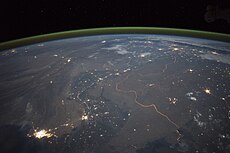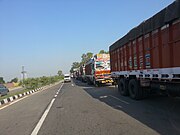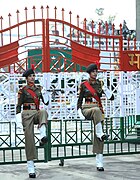India–Pakistan border
| India–Pakistan border | |
|---|---|
 Nighttime panorama of the border from outer space, stretching from the Arabian Sea to the foothills of the Himalayas | |
| Characteristics | |
| Entities | |
| Length | 3,323 kilometres (2,065 mi) |
| History | |
| Established | 17 August 1947 Creation of the Radcliffe Line by Sir Cyril Radcliffe due to the Partition of India |
| Current shape | 2 July 1972 Demarcation of the Line of Control after ratification of the Shimla Treaty |
| Treaties | Karachi Agreement (1949), Shimla Agreement (1972) |
| Notes | The Line of Control separates Kashmir between India and Pakistan, it is not an internationally recognized border |
The India–Pakistan Border, known locally as the International Border (IB), is an international border running between Pakistan and India. The border runs from the Line of Control (LoC), which separates Indian-administered Kashmir from Pakistani-administered Kashmir in the north, to Sir Creek in Rann of Kutch between the Indian state of Gujarat and the Sindh province of Pakistan in the south.[1]
Drafted and created based upon the Radcliffe line in 1947, the border, which divides Pakistan and India from each other, traverses a variety of terrains ranging from major urban areas to inhospitable deserts.[2] Since the independence of India and Pakistan (see British India), the border has been a site of numerous conflicts and wars between each country, and is one of the most contested borders in the world.[2] The border's total length is 3,323 km (2,065 mi),[2] according to the figures given by the PBS; it is also one of the most dangerous borders in the world, based on an article written in the Foreign Policy in 2011.[3] It can be seen from space at night due to the 150,000 flood lights installed by India on about 50,000 poles.[4][5]
Working Boundary, Line of Control, and International Boundary[]

The border between the two nations is an internationally recognised frontier from Gujarat/Sindh only with exemption to the Line of Control that is not internationally accepted. The disputed region of Kashmir got divided through the Indo-Pakistani War of 1947 into the regions of Pakistan-administered Kashmir and Indian-administered Kashmir. The UN-mediated ceasefire line of 1949 served as the de facto border between the two regions, which was revised to a Line of Control after the Indo-Pakistani War of 1971.[6]
The border between Indian-administered Kashmir and the Pakistani province of Punjab is officially called the "Working Boundary" by Pakistan. India regards it as the international border.[6]
Sections of the India–Pakistan border from north to south:
- Line of Control (LoC): De facto boundary between Indian-administered Kashmir and Pakistani-administered Kashmir. Its current form was demarcated after the 1972 Simla Agreement.
- Working Boundary: Separates Punjab, Pakistan from Indian-administered Jammu and Kashmir. It is referred to as a working boundary by Pakistan because it is subject to a one-way dispute; Pakistani Punjab is internationally recognized as part of Pakistan by both parties while Jammu and Kashmir is a disputed territory (claimed by Pakistan, controlled by India).[7][6]
- International Boundary (IB): The demarcated line between the Republic of India and the Islamic Republic of Pakistan, recognized by both sides internationally. The boundary was drawn by Sir Cyril Radcliffe during the Partition of India by the British Empire in 1947.
Border crossings[]
- ICP Border crossings with designated Integrated Check Posts (ICP) with immigration and customs facilities are:
- Attari and Wagah, is the most famous and prominent border crossing point between India and Pakistan due to Wagah-Attari border ceremony. The crossing is located 32 kilometres from Amritsar and 24 kilometers from Lahore.
- Munabao : This village situated at Barmer district in Rajasthan, is famous for the railway station through which, the Thar Express connecting India with Pakistan runs. The crossing point had been closed after the Indo-Pakistani War of 1965. In February 2006 it was reopened and since then the Thar Express operates from Bhagat Ki Kothi in Jodhpur, India to Karachi, Pakistan.[8]
- Other crossings
- Ganda Singh Wala border, Kasur District (Pakistan side) / Hussainiwala border, Punjab (India side)
- Sulaimanki, Punjab (Pakistan side) / Fazilka border, Okara District (India side)
- Longewala (closed)
Border ceremonies[]

List of Indo-Pak border ceremonies[]
At the following border crossing sites the beating retreat flag ceremonies are jointly held by the military of both nations every day at 6 pm, which are open to public as tourist attractions.[9][10] No special permit or ticket is needed. The ceremony sites are as follows (from north to south):
- Punjab, India-Punjab, Pakistan
- Wagah-Attari border ceremony near Amritsar in Punjab.[9][10]
- Rajasthan-Sindh
- Munabao-Khokhrapar border ceremony in Barmer district in Rajasthan.[9][10]
Wagah–Attari border ceremony[]
The flag lowering ceremony at the village of Wagah is held each evening immediately before sunset by the border agents of Pakistan (Pakistan Rangers) and India (Border Security Force or BSF).[14] It is a tradition dating back to 1959. The ceremony begins with battle calls from both sides in the form of loud screaming done by the border guards. This is followed by a series of organized high kicks, stomps, and dance moves during which the opposing forces stare each other down.[15] The event ends with a handshake of good faith being exchanged by the head guards along with the lowering of the flags.[15] The crowd cheers and claps enthusiastically through it all. The ritual is known to attract international tourists and even celebrities.[15] It is symbolic of the brotherhood as well as the rivalry that these two nations share.[15] The border troops are known to exchange sweets with the opposing side during the Muslim holidays of Eid and Hindu holiday of Diwali, but in 2016 and 2018 the BSF have avoided doing so due to rising military tensions. It has been a peaceful gathering with the exception of the 2014 Wagah border suicide attack in which 60 people were killed and over 110 people were left injured.[16] It has also been cancelled on occasion such as when Pakistan returned Wing Commander Abhinandan Varthaman back to India after his plane was shot down by the Pakistan Air Force (PAF) during the 2019 India-Pakistan standoff.[17]
Similar border ceremonies held by India (Border Security Force, BSF) and Pakistan (Pakistan Rangers) occur at Fazilka border (India side) / Sulaimanki, Punjab and Hussainiwala border, Punjab (India side) / Ganda Singh Wala border, Kasur District (Pakistan side). These rituals are attended primarily by the local villagers and garner very few spectator tourists.[citation needed]
International relations[]
This section needs expansion. You can help by . (July 2020) |
China: Pakistan has a long running relationship with China, with collaboration in trade, military, and technology; Each considering the other a close strategic ally.[18] China is Pakistan's largest supplier of weapons and one of its largest trading partners.[19] There are strong military ties between China and Pakistan beyond the supply of weapons. This alliance between two neighboring Asian nations is significant geopolitically, as the strong military ties counter regional Indian and American influence. The Sino-Indian border dispute is co-existing along Line of Actual Control as well as on the economic front. China has continued to support Pakistan on its internationalization of Kashmir conflict for resolution as per specific UNSC resolutions.[20][21]
Gallery[]

"Baba Chamliyal Mela" traditional celebration at the India–Pakistan border near Ramgarh, 45 km (28 mi) from Jammu, where both Indians and Pakistanis take part in festivities.

Evening Wagah–Attari border ceremony, as seen from the Pakistani side.

The floodlit border zone between Pakistan and India seen from outer space.

Trucks on the former Indian National Highway 1, waiting to cross the border at Wagah–Attari.

Pakistani Ranger standing guard at the Wagah border crossing.

Female Indian Border Security Force personnel taking part in the ceremonial retreat at the India–Pakistan border crossing (Wagah–Attari), 2010.

Map of the India–Pakistan border along the Rann of Kutch between Gujarat, India and Sindh, Pakistan.

India-Pakistan border at Wagah, 2017
See also[]
- Borders of India
- Borders of Pakistan
- Partition of India
- India–Pakistan border skirmishes (disambiguation)
References[]
- ^ Khan, MH (5 March 2006). "Back on track". Dawn News archives. Retrieved 15 April 2013.
- ^ Jump up to: a b c PBS Release (26 July 2005). "Border Jumpers The World's Most Complex Borders: Pakistan/India". PBS. Retrieved 15 April 2013.
- ^ PHILIP WALKER (24 June 2011). "The World's Most Dangerous Borders". The Foreign Policy. Retrieved 15 April 2013.
- ^ "India-Pakistan Borderlands at Night". India-Pakistan Border at Night. NASA. 23 September 2015. Retrieved 14 October 2015.
- ^ "Annotated image from NASA".
- ^ Jump up to: a b c Library, C. N. N. (8 November 2013). "Kashmir Fast Facts". CNN. Retrieved 20 April 2019.
- ^ "From Line of Control to Working Boundary". Daily Times. 3 March 2018. Retrieved 9 December 2020.
- ^ "Radcliffe Line to divide India-Pakistan was formed this day: Read about it here". India Today. 17 August 2016. Retrieved 30 July 2018.
- ^ Jump up to: a b c d 5 crossing points in India: All you need to know, India Today, 10 OCt 2016.
- ^ Jump up to: a b c d Beating Retreat Wagah India, CHanging Guards, accessed 8 July 2021.
- ^ Sadqi retreat ceremony, nic.in, accessed 8 July 2021.
- ^ Second Wagah: India, Pak agree to new ceremony, beating retreat on Punjab border, Hindustan Times, 201 April 2017.
- ^ At Sadiqi border, strained Indo-Pak ties dampen spirits, The Tribune, 17 April 2019.
- ^ Khaleeli, Homa (1 November 2010). "Goodbye to the ceremony of silly walks between India and Pakistan". The Guardian. ISSN 0261-3077. Retrieved 19 April 2019.
- ^ Jump up to: a b c d Clark, Tawny. "India and Pakistan's beautiful border ritual". www.bbc.com. Retrieved 20 April 2019.
- ^ "Pakistan border bombing kills dozens". 3 November 2014. Retrieved 20 April 2019.
- ^ "Daily Retreat ceremony along Attari-Wagah border cancelled: BSF". The Economic Times. 1 March 2019. Retrieved 20 April 2019.
- ^ "Pakistan fighters in biggest 'real-combat level' drill with China months after post-Balakot dogfight with India". Hindustan Times. 7 September 2019.
- ^ "Pakistan (PAK) Exports, Imports, and Trade Partners". oec.world.
- ^ "China firmly with Pakistan, says Beijing as Islamabad raises Kashmir in top talks". Hindustan Times. 19 March 2019.
- ^ "'Help Kashmiris achieve right of self-determination': Pak PM Imran Khan urges UN". Hindustan Times. 18 February 2020.
External links[]
 Media related to India-Pakistan border at Wikimedia Commons
Media related to India-Pakistan border at Wikimedia Commons- "How this border transformed a subcontinent | India & Pakistan". Vox. 26 June 2019.
- International Boundary Study No. 86 – 2 December 1968 India – Pakistan Boundary
- India–Pakistan border
- Borders of India
- Borders of Pakistan
- International borders







